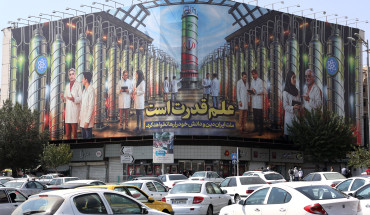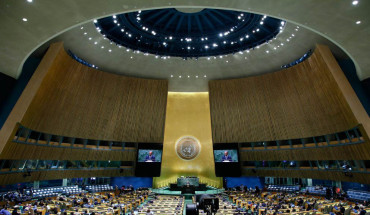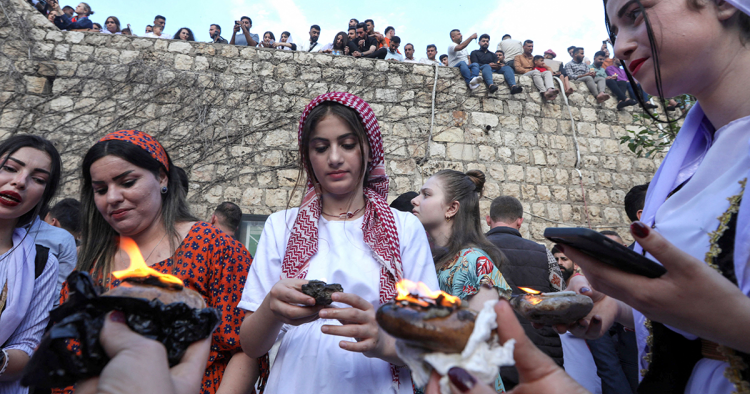This article is part of the Democracy, Human Rights, and Governance Initiative, MEI’s look at the evolving threats to freedom, political rights, and civil liberties, as well as the struggles to achieve fair, transparent, and representative governance across the MENA region.
Iraq has long had a troubled history with its ethno-religious minorities, one full of oppression and violence. This was true under the Ba’athist regime that came to power in the late 1960s and continued after the 2003 U.S.-led invasion that further plunged the country into chaos and conflict, reaching a nadir with the rise of the Islamic State (IS) terrorist group, whose legacy continues to reverberate more than five years on from its territorial defeat.
IS particularly targeted ethno-religious minorities living in Nineveh, a multi-ethnic and multi-religious province that is home to Assyrian, Chaldean, Kaka’i, Shabak, Syriac, Turkmen, and Yezidi communities.1 These communities lived side by side as part of Iraq’s rich mosaic of cultural diversity. The immense destruction and suffering that IS wrought was a deliberate bid to erase not only these minorities’ cultural identity, but also the traces of centuries of ethno-sectarian coexistence, a notion that the group vehemently rejects. IS’s three-and-a-half-year reign in northern Iraq, between 2014 and 2017, threatened cultural diversity as the group sought to impose a monolithic and radical form of Sunni Islam that entailed the forced conversion, enslavement, and execution of these minorities.
Although Iraq is now enjoying its most stable period in the past two decades, it is also a case study of the pernicious effects of structural violence, especially toward the more marginalized and vulnerable segments of society. Minorities scattered across northern Iraq are not only living on the geographical margins of peri-urban areas but also on the margins of society and its structures, with mere symbolic political representation, frozen social mobility, and constant stigmatization where negative stereotypes abound and are frequently espoused as facts.
Moreover, while armed conflict and violence have abated, structural violence endures. According to the 2022 State Department reports on Human Rights Practices and Religious Freedom, restrictions on freedom of religion as well as violence against and harassment of minority groups remain widespread in many parts of the country outside the Kurdistan Region, known for its outwardly favorable environment to religious diversity and expression. Minorities continue to face hate speech and different forms of deeply ingrained prejudice that stem primarily from common misconceptions and lack of respect (and disregard) for diversity and inclusivity. In addition to grappling with the ramifications of the conflict, minorities are still treated with disdain, and their cultural resources and practices are viewed with derision.
In April 2023, Yezidis became the target of a campaign of hate speech and false accusations, which included rhetoric that condoned the crimes committed against them by IS. The proliferation of hate speech on social media started after Yezidis were wrongly accused of burning a mosque in Sinjar district2 during a peaceful demonstration against the return of families suspected of being affiliated with IS. In the ensuing days, despite reassurances from government officials and religious authorities, old pictures continued to circulate online. The photos showed the mosque after it was damaged in the 2016 military operation to liberate Nineveh from IS and incorrectly attributed the damage to the recent protests. Thousands of posts on social media incited violence against Yezidis, calling them infidels and repeating harmful tropes about devil worship. The incident reinvigorated debates about the lack of tolerance and respect for diversity, the manipulation of popular sentiment, and the deliberate use of misconceptions and myths to instill distrust and hatred toward minorities.
Underlying misconceptions
Skewed understandings of minority groups rooted in erroneous interpretations of their faith, sacred rites, and symbols remain widespread in Iraq, as the educational curriculum tends to focus mainly on the teachings of Islam. In the Yezidi religion, for example, the peacock angel is believed to be the ruler of the earth, but it is often conflated with and misunderstood as Satan. This misconception has caused Yezidis to be falsely labeled or portrayed as devil worshippers and polytheists — a pretext that IS used to carry out its brutal campaign against the community. One Yezidi religious hymn recalls 72 episodes of persecution, known as farmans, throughout their history, the latest being the 2014 IS attacks on Sinjar that were so devastating that they have since been recognized as genocide.
Many minority groups are trapped in a vicious circle. Facing threats to their faith and livelihood, they live in isolation and practice their rituals in secret to preserve their communities and cultural identity. At times, some groups have even had to migrate elsewhere to practice their faith freely and without persecution. This same isolation and secrecy, however, creates the grounds for others to spread dangerous myths about them that reinforce the underlying misconceptions and harmful stereotypes, leading to even more intolerance against them. Many minority groups, especially those practicing non-evangelistic (non-Abrahamic) faiths, maintain secrecy around their religious rites and rituals. This opens the door for rumors and allegations against them and their beliefs, making it easier for others to hold preconceived notions about them.3
Social isolation among different groups is another factor contributing to reinforcing myths and misconceptions. For example, activities that previously promoted social cohesion between ethno-sectarian groups in Nineveh, such as seasonal commemorations and large celebratory gatherings, were disrupted by the displacement and destruction wrought by IS. Some of these occasions involve the participation of elders, religious figures, and other notables, helping to further reinforce inter-group solidarity.
An emphasis on religious teaching is seen to perpetuate social and cultural cleavages, and religious education is unequal in focus. Members of minority groups are not afforded the same opportunities to learn about their religion and culture. Conversely, members of the majority groups are also not afforded opportunities to learn about the beliefs and practices of religious minorities. The educational curriculum neither reflects the multi-ethnic and multi-religious nature of Iraq, nor does it promote respect for diversity and pluralism or civic education. The glorification of ancient Islamic conquests, minorities argue, also fuels hatred toward them. Prejudice is learned from an early age and passed down to the next generations at the household or school level. Many parents teach their kids negative things about their non-Muslim neighbors — that they “do not worship the same God,” “do not believe in God or the Quran,” and “do not fast.” Non-Muslim minorities continue to face pressure and harassment to observe Islamic customs, with some even reporting that their kids are told at school to fast and pray.4
Marginalization and recognition
Minority groups that lack formal recognition continue to push for their inclusion in the constitution and legislation regulating their rights or religious freedoms. However, there are several different levels of recognition and inclusion.5 The first level is official recognition, which includes being mentioned in the constitution, in legislation, and so on. This is necessary but not sufficient as it tends to conceal minorities’ underlying suffering and does not translate into actual inclusion and religious freedom. The second level is recognition by the traditional Islamic religious authorities. The third and arguably most important level is popular recognition, which is often tainted by stereotypes, misconceptions, and prejudice that fuel hate speech and discrimination on a day-to-day basis. For instance, while Yezidis and Mandaeans are recognized in the 2005 Iraqi Constitution, and given a quota of seats in parliament, their religions are not treated on an equal footing with Islam.6 This is a clear indication that official recognition remains limited and cannot be reduced to the legal level in the constitution and legislation or to the political level through participation in parliament. Minority groups remain marginalized and excluded from peace processes in their areas and have yet to be given effective and meaningful political participation, which is essential for them to be able to raise their issues and concerns. Adequate recognition entails dispelling common misconceptions, correcting stereotypes, and tackling the deeply ingrained prejudices against minority groups to ensure equality and inclusion on the broader societal level.
Socioeconomic discrimination
Non-Muslim minorities, especially Kaka’is and Yezidis, also face discrimination and exclusion in the labor market, including employment in the government, judiciary, and public sector. Worse still, because of prevailing misconceptions, they cannot open or work at bakeries, restaurants, or butcher shops, ostensibly for not following Islamic tradition while carrying out animal slaughter or preparing meals. Moreover, their foodstuffs and produce, such as cheese, bread, yogurt, meat, and so on, are often boycotted ostensibly for not being halal (religiously permissible) or hygienic. Yezidis and Kaka’is stress that members of Muslim communities often avoid buying produce from non-Muslim minorities, and they frequently have to hide their faith from potential customers to be able to sell their foodstuffs.7
Social and economic prejudice and otherwise undeclared boycotts of minorities’ foodstuffs sometimes happen during important socio-religious periods or events, like seasonal commemorations, celebrations, funerals, and so on. Non-Muslim minorities report that more conservative Muslims, regardless of their ethnicity or denomination, refuse to share food or eat with them, often attending these occasions after the meals are over to avoid eating.8 Yet these socio-religious occasions are also viewed as an important opportunity to celebrate diversity and strengthen intercommunity solidarity and social cohesion by bringing together people from different cultural and religious identities and backgrounds.
Intolerance and hate speech
Intolerance and hate speech are an everyday occurrence. Whether spread by religious figures, politicians, media outlets, or average citizens on social media, hate speech taps into deeper structural problems of inequality in Iraqi society. Religious and cultural values, both officially and socially, are attributed to the majority population’s faith; Islam is regarded as the state religion, and there is an underlying perception of minorities’ social inferiority. Such deeply ingrained prejudice creates an environment that accepts and perpetuates hate speech.
Mistreatment, verbal abuse, and hate speech against ethno-religious minorities continue to occur, particularly when political tensions are high, in public places like the bazaar and the workplace as well as on social media.9 This is frequently linked to underlying public misconceptions. For example, Kaka’i and (some) Yezidi men are often distinguishable from others by their long mustaches; growing a mustache symbolizes devotion and piety among Kaka’is,10 and manhood and boldness for Yezidis — although it is no longer strictly adhered to. This tradition, however, is not well understood and can be seen as unhygienic among other communities. As a result, Yezidis and Kaka’is can still become the subject of derogatory comments or insults, both in person and on social media, for their long mustaches. According to Islamic law and tradition, a mustache must be kept short and trimmed.
On the other hand, the Shabak and Turkmen adherents of Shi’a Islam report facing derision and hate speech in the traditional media as well as on social media while practicing certain annual sacred rituals. In remembrance of the martyrdom of Husayn ibn Ali, the grandson of the Prophet Muhammad, Shi’a Muslims in Iraq observe Ashura and Arba’een as days of lamentation — a religious obligation or commandment marked by mourning processions and acts of self-flagellation. These rituals of remembrance, which have turned into a rallying cry for the most vulnerable and marginalized communities against injustice, inequality, and exclusion, are reportedly viewed as denoting ignorance or even heresy among people from other ethno-sectarian groups.11
Shabaks, who are mainly found in rural parts of Nineveh, say they are portrayed and viewed as uncivilized people from the countryside, and thus not necessarily deserving of better access to public services and representation in local administration. In the same vein, Christians are considered “too liberal” or “too loose” socially12 — an insinuation that they ostensibly tolerate “socially unacceptable” values or practices, such as mixing between genders during congregation and socio-cultural occasions. In the Yezidi and Christian faiths, the segregation of men and women is not seen as necessary. By contrast, in Islam such interactions should be kept at a modest level.
What needs to change?
A range of measures are necessary to address the underlying misconceptions and deeply ingrained prejudices against ethno-religious minorities in Iraq. First, the government needs to enact relevant legislation to fulfill its commitment to respect diversity and preserve pluralism by including minorities in public life and ensuring the right to effective and meaningful political participation. This should be combined with support for grassroot efforts such as Masarat and Tech for Peace that seek to promote social cohesion and tolerance through interfaith dialogue, tackling hate speech and misinformation. Religious institutions and leaders can also play a role in preventing violent extremism and highlighting respect for Iraq’s diversity. These initiatives, however, need to go beyond the community elite to include laypeople, who are more prone and likely to repeat harmful misconceptions and stereotypes.13
Second, it is also important to redevelop the curriculum with an emphasis on respect for diversity, human rights, and civic education. The curriculum should reflect Iraq’s rich mosaic of cultural diversity and contribute to the consolidation of values of citizenship and the formation of a national identity that bridges parochial differences. This is in line with the efforts of many grassroots and civil society groups to reimagine Iraqi politics such that identity, including ethnicity and sect, plays a much smaller role. Instead, issue-based politics is given more prominence — as has been evident in the large social protest movements that have gripped the country since 2018. In addition, there is also growing support for a madani (“civil”) state as a preferred political outlook and type of government in Iraq in response to the role of religious forces in society, such as Islamist parties and paramilitary groups.
Finally, stakeholders involved in post-conflict reconstruction efforts should go beyond physical reconstruction by paying more attention to the role of cultural and religious practices in restoring peace and helping communities to heal and recover. Developing and building public spaces, like community centers, sports facilities, and so on, as part of social cohesion programs could help facilitate interaction and cultural exchange between different ethno-sectarian groups. There is also a role for members of different communities to play through inter-faith dialogue initiatives and other efforts to deepen intercommunity understanding. To be sure, preserving Iraq's rich mosaic of cultural and religious diversity requires everyone to value the very diversity that had given rise to many of the world’s earliest civilizations. Ensuring equality and inclusion of minorities on the broader societal level is an important place to start.
The international community and the United States can play a role here too. The U.S. and the Government of Iraq have stated their commitment to the protection of human rights and fundamental freedoms as part of the U.S.-Iraq strategic dialogue. It is therefore imperative for Washington to live up to its promises and not overlook the increasing human rights violations and violence against and harassments of minorities. Insistence on respect for democracy and human rights should be an essential pillar of America’s partnership with and support for Iraq. This requires the U.S. to take a clear stance that reflects its values and interests in the country. The U.S. should press the Iraqi authorities to fulfil their numerous pledges to protect and support minorities if they want to preserve the country’s rich mosaic of diversity and sustain peace and stability in the long run.
Shivan Fazil is a researcher with the Middle East and North Africa Program at the Stockholm International Peace Research Institute. His work mainly focuses on drivers of conflict, peacebuilding, and governance in Iraq.
This publication was made possible through support provided by the Innovation, Technology, and Research Hub of the U.S. Agency for International Development, through the LASER PULSE Program. The opinions expressed herein are those of the author and do not reflect the views of the U.S. Agency for International Development.
Photo by SAFIN HAMID/AFP via Getty Images
Endnotes
- Christians from Iraq comprise Assyrians, Chaldeans, and Syriacs. Kaka’i, also known as Yarsan or Ahl-e Haqq, are generally considered to be Kurdish in ethnicity and classified by some as an independent religion and others as a sect and subgroup of Islam. Similarly, the Yezidis are considered by some as a distinct ethno-religious group and as a religious subgroup of the Kurds by others.
- Sinjar is a disputed territory between the federal government of Iraq and the Kurdistan Regional Government. The dispute has blocked reconstruction plans and impeded returns.
- Author’s interview with diversity and interfaith expert from Baghdad.
- Author’s interview with Kaka’i community leader from Hamdaniya.
- Author’s interview with diversity and interfaith expert from Baghdad.
- Author’s interview with diversity and interfaith expert from Baghdad.
- Author’s interview with Kaka’i and Yezidi community leaders from Nineveh.
- Author’s interview with Kaka’i community leader from Hamdaniya.
- Author’s interview with Kaka’i community leader from Hamdaniya.
- Author’s interview with Kaka’i community leader form Hamdaniya.
- Author’s interview with Shabak community leaders from Bartella and Hamdaniya.
- Author’s interview with diversity and interfaith expert from Baghdad.
- Author’s interview with Shabak community leader from Bartella.
The Middle East Institute (MEI) is an independent, non-partisan, non-for-profit, educational organization. It does not engage in advocacy and its scholars’ opinions are their own. MEI welcomes financial donations, but retains sole editorial control over its work and its publications reflect only the authors’ views. For a listing of MEI donors, please click here.













